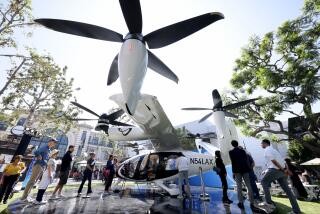Start-ups are racing to get electric bikes to market
When it comes to electric vehicles, the Tesla Roadster and Chevrolet Volt get all the love. But there are other EVs rolling around, and they’re balancing on two wheels.
Since 2007, when Vectrix of Middletown, R.I., first rode onto the scene with its battery-powered Maxi Scooter, a growing number of U.S. start-ups have entered the plug-in two-wheeler market. They’ve invested millions of dollars in vehicles, many of which are poised for production within a year.
Led by pioneers with impressive resumes, these firms predict growth in spite of the down economy, and they’re laying claim to niche markets with such boasts as “first” and “fastest” as they stake out territory in what many believe is the future of transportation.
“It’s amazing how inefficient the vehicles we’re driving today really are,” said Forrest North, founder and chief executive of Mission Motor Co., a San Francisco company that unveiled the prototype for its 150-mph, 150-mile-range electric motorcycle at the Technology, Entertainment, Design conference in Long Beach last month. “Electricity is just so many orders of magnitude more efficient that it’s the only way to go,” said North, a former mechanical designer for Tesla and leader of Stanford University’s solar car team in the mid-1990s.
Like many EV entrepreneurs, North, 33, had looked into hydrogen and biodiesel as power sources but found them impractical. Hydrogen is abundant, but turning it into fuel and developing a distribution infrastructure are costly. Biodiesel can take more energy to produce than it generates.
With electricity, the infrastructure already exists: Electrical outlets are abundant. Battery technology is also improving about 8% each year, North said, allowing bikes to easily upgrade once the chemistry comes along. Already, electric two-wheelers get the equivalent of about 300 to 500 miles per gallon. As technologies improve, they’ll be able to generate even more energy with less weight and cost.
Billed as “the world’s fastest production electric sport bike,” Mission’s debut product is called the Mission One. It is scheduled to ship in early 2010, at an estimated retail price of $68,000 -- most of which is attributable to a large lithium-ion battery pack designed to compete with a gas-powered, performance-oriented sport bike.
It’s the power-to-weight ratio of existing batteries that is, in part, driving development of electric two-wheelers. Weighing less than 25% of a typical passenger car, two-wheeled scooters and motorcycles require fewer expensive batteries to bring them to speed. They are also simpler machines; they require fewer components and safety features and aren’t subject to the same stringent governmental requirements as passenger cars.
That makes two wheels a less complicated and less expensive entry point than cars for electric drivetrain entrepreneurs, which is why electric two-wheelers also are coming on the market much faster, and more affordably, than their four-wheeled brethren. Most currently available production electric two-wheelers cost less than $10,000.
Vectrix was the first company to manufacture a production electric two-wheeler. Since introducing its $11,000, 62-mph Maxi Scooter in August 2007, it has unveiled a second model and sold more than 1,500 vehicles globally. Though that isn’t a lot compared with the millions of cars sold every year, it represents a 300% increase in annual sales from 2007 to 2008. This year the company says it’s on track for 150% sales growth.
“Any time you bring a new technology to market, when you can horizontally grow that product, it validates to the consumer that it’s a real technology,” Vectrix CEO Mike Boyle said. This spring Vectrix will roll out a third scooter model, the $5,195, 30-mph VX-2.
Spring is also the target launch season for two other electric two-wheelers -- Zero Motorcycles’ Zero S and Brammo Motorsports’ Enertia. Like Vectrix, the S and Enertia are oriented toward the commuter market. Unlike Vectrix, they are motorcycles.
“The market is definitely getting excited for an electric motorcycle,” said Neal Saiki, 42, founder of Zero Motorcycles in Santa Cruz. “It’s going to grow really rapidly as people realize how practical and fun and fast these motorcycles are. They can be environmental and have fun.”
Zero was the second manufacturer, after Vectrix, to make a production electric two-wheeler. Founded by Saiki, a former NASA engineer, and funded in part by former Sun Microsystems executive Gene Banman, who now serves as Zero’s CEO, the company has sold 200 of its $7,500 Zero X models -- an off-road electric motorcycle with a 50-mph maximum speed and 40-mile range off a single charge. This year it expects to sell at least twice as many bikes as it expands its model offerings with an S model -- a supermoto-style, street-legal bike with a top speed of 70 mph and a maximum range of 60 miles per charge.
Hundreds of bikes isn’t much of a return on the millions of dollars that have been invested so far in Zero, but Saiki sees a strong market. By 2011, he anticipates Zero will be in the black and doing $100 million in business.
Not to be outdone, Honda and Yamaha have said they’ll be coming out with electric motorcycles in two years.
Though a rapidly deteriorating global economy and relatively low gasoline prices may not seem like ideal conditions for launching or ramping up a company in an unproven field, many of the two-wheeled-EV start-ups say they have benefited from it. Craig Bramscher of Brammo Motorsports in Ashland, Ore., says he raised $10 million in venture capital last year -- all of it after the financial system froze up in September.
And when the first of his planned 300 Enertia bikes rolls off the line in May, he’s thinking his firm will be aided by the government’s $787-billion economic stimulus package. The program includes a 10% tax credit on the purchase price of two- and three-wheeled electric vehicles with batteries generating at least 2.5 kilowatt-hours of power.
“It seems like the right place, right time,” said Bramscher, 48, former owner of Santa Monica software technology firm Dream Media. “A lot of people haven’t forgotten we’ve got an oil problem.”
Brammo’s Enertia claims a top speed of 50 mph, a 35- to 45-mile range on a single charge of its lithium-ion battery pack and a $8,995-to-$14,995 price tag. The cheapest version reflects a battery-lease program that reduces the bike’s cost, bringing it more in line with similar, gas-propelled products.
“If you buy an electric vehicle, it’s like buying three years’ worth of gas because the batteries are the lion’s share of the propulsion cost,” said Bramscher, who’s experimenting with distribution as well. In May he’ll launch a pilot program at a handful of Best Buy stores, where the bike can be test ridden before purchase.
Although Bramscher is confident in his product and his business mode, he’s hesitant to discuss sales projections.
“If the people expressing interest in test rides is any indication, it could be tremendous,” he said. “I don’t want to say numbers, because it almost seems insane.”
--






